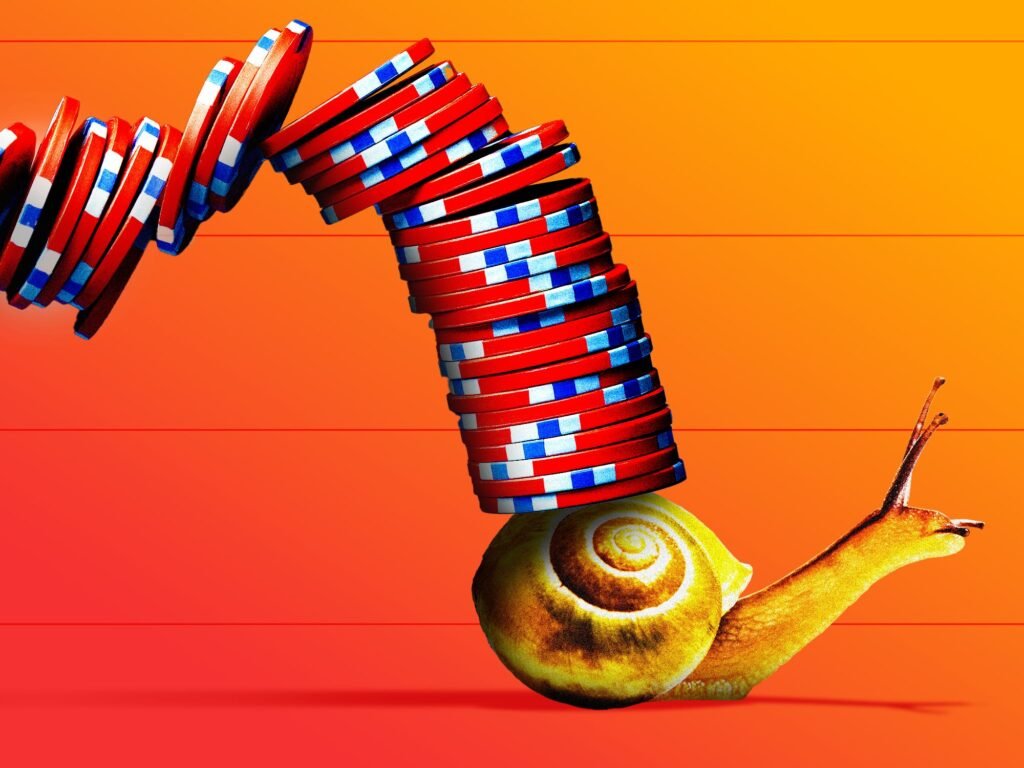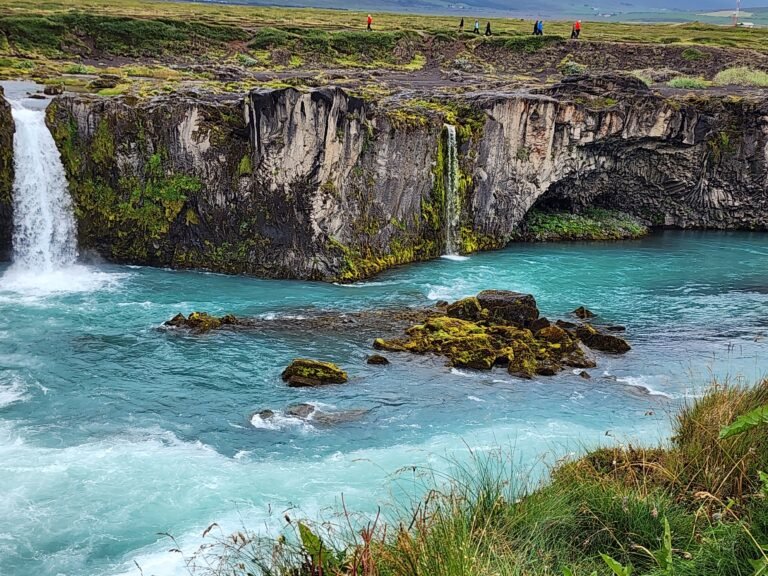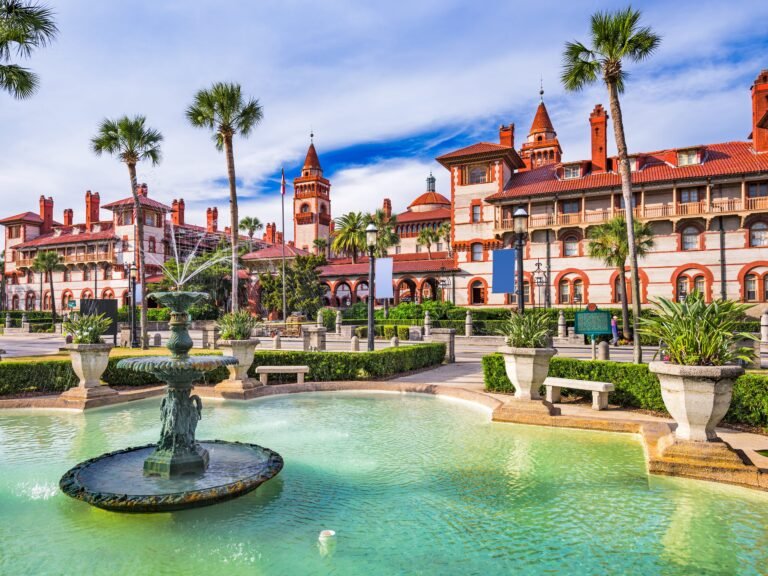
Getty images; Tyler Le/BI
Despite what you may have seen on the internet lately, Las Vegas is not dead. The casinos are not empty. The streets aren’t bare. If I’m being honest here, I wouldn’t have minded a little less crowding during my little mid-August gals’ jaunt to Sin City in an ill-fated attempt to see Kelly Clarkson, who canceled her residency there this month. But the vibe in Vegas is different. It’s a slow summer, and it shows.
Touristically speaking, this has been an unfun year for Vegas. The Las Vegas Convention and Visitors Authority says visitor volume to the city fell by 11.3% in June compared to the prior year. Convention attendance and hotel occupancy declined, too. The total number of visitors is down 7.3% over the first half of 2025. Gaming revenue is up, a signal that the people who are going are still gambling. But consumer spending, including at restaurants and bars and apparel and jewelry retailers, is down millions of dollars over the last 11 months compared to the prior stretch. Some casinos have laid off workers.
Why this is happening doesn’t have one straight answer. A lot of factors are in play — the rocky state of the economy, tighter US immigration policies, hangover effects from the California wildfires that have some would-be visitors staying home. The tentpole events that drew in scads of visitors in recent years, such as March Madness and the Super Bowl, aren’t around this year for a 2025 boost. There are still Formula 1, the Raiders, and whatever is going on with the Sphere, which is hosting the Backstreet Boys, but those attractions are extra pricey in a moment when many travelers are feeling extra price sensitive.
Las Vegas has relatively recently developed a reputation for being expensive and for nickel-and-diming people at every opportunity. The costs of plane tickets, hotel rooms, food, drinks, and even parking have skyrocketed. The nature of the city has changed, too. Instead of existing as America’s slightly seedy city of vice, Vegas has gotten a sort of glow-up in an attempt to broaden its appeal. The upside: A broader audience might be up for a trip to Vegas than in the past. The downside: Vegas now resembles so many other destinations that it loses out to similarly priced (or even cheaper) competitors, especially if visitors aren’t having a bang-up time.
“You’re starting to change the mentality of the visitor where they’re thinking, ‘Well, I could go to Las Vegas, but it’s going to be a pain in my neck, or I could go to Cancún,'” says Michael Schoenberger, a professor of hospitality management at the College of Southern Nevada. “It’s a cumulative effect that’s just now starting to show up.”
While the “what’s wrong in Las Vegas” conversation is peaking right now, things have been shaky for a while, says Amanda Berlarmino, an assistant professor of hospitality at the University of Nevada, Las Vegas. “To be honest, we’ve struggled with visitation since the pandemic,” she says.
Asian tourism has not recovered, she says, and this year, there’s been a decline in other international visitors, including, importantly, Canadian tourism, thanks in part to President Donald Trump’s antagonism towards America’s neighbors to the north. International visitors tend to do longer stints than domestic visitors, who might just pop down for a weekend, which makes their pullback cut a little deeper.
We are a more expensive market now than we’ve ever been before.
The domestic picture isn’t especially pretty, either. Worries about the economy may be keeping Americans at home. A disproportionate amount of Las Vegas visitors tend to come from California, but the number of vehicles crossing the California-Nevada border on Interstate 15 declined by 4.3% in June compared to the same month last year. Berlarmino chalks much of it up to the fires that hit Southern California at the start of the year. Schoenberger notes that disruptions from highway construction have been a problem, too.
Steve Hill, the president and CEO of the LVCVA, says while these issues are not ideal, Las Vegas has seen worse in the recent past. “It is not the crisis situation like we’ve seen through Covid or the extended downturn through the Great Recession,” he says.
Beyond some of these more acute issues, one major complication that’s gradually been growing may finally be reaching an inflection point: pricing. To put it plainly, Las Vegas is hella expensive.
The longtime proposition of Las Vegas was that it was relatively cheap to get there and stay there, because once people got there, the amount they spent on gambling at the casinos and resorts more than made up for it. But that’s no longer the case. Flights to the city may still be slightly less expensive than some destinations, but they’re not that far from trips to New Orleans, Miami, or Washington, DC. The same goes for hotels, though prices can vary widely. The typical clientele has also shifted. While Las Vegas’ traditional market was people over 60 who tended to be value-conscious, now more people are coming in their prime earning years and demanding more premium services and experiences. Resort economics have changed, too. Gambling is no longer so important as a revenue driver — it’s hotel rooms, food and beverage, and events. Combine all of that with inflation and consumer wallets being squeezed, and you can see why some visitors may shorten trips or just scrap them altogether.
“We are a more expensive market now than we’ve ever been before,” Berlarmino says.
Many Las Vegas casinos and hotels started charging for parking in the mid-2010s, and they’re piling on resort fees, too. My recent four-night stay at the Cosmopolitan Hotel included $249.44 in resort fees and associated taxes. While there are ways to do Las Vegas that aren’t so costly — staying in budget or value hotels away from the Strip, buying food and alcohol at a store, or abstaining from drinking entirely — all the little add-on fees can make people feel like they’re being ripped off.
“Since starting right before the pandemic and then continuing after the pandemic, we’ve introduced a lot of pain points to the visitors that historically were not present,” Schoenberger says. “Why we charge people to drink what drinks cost in New York City, I have no idea.”
Hill says that the narrative around the cost of Vegas is “overblown,” and says there are “all kinds of ways” to achieve a budget-friendly experience. “We’ve got 150,000 rooms and they, right this minute, run from $9 probably to $600,” he says. The slowdown in visitors has led some hotels to cut their prices, he adds.
Why we charge people to drink what drinks cost in New York City, I have no idea.
Gambling being more widely available around the US is both a blessing and a curse for Las Vegas, which used to be one of two major places in the states, along with Atlantic City, where you could legally bet. On the one hand, people who have the gambling itch can probably find a place to scratch it within a couple of hours from their homes. On the other hand, the proliferation of gambling may also mean more people get the itch.
Chris Grove, a sports-gambling-industry investor at Acies Investments, tells me the growth of sports betting has been “nothing but a net positive for Vegas.” It’s given people a taste of betting, and if they like it, it might inspire them to go to the biggest place in America there is to do it.
Grove compared it to the poker boom of the early 2000s. “Online poker got really popular, and you ask the question: Did that do anything to dissuade people from coming to Vegas to play poker? And the answer is no,” Grove says.
Plus, summer is a slow time for sports gambling. If people were sitting home on their couches on sports betting apps instead of going to Vegas, they’d be doing so during the NFL season and March Madness.
Other Vegas developments have been a mixed bag. Formula 1, back in Vegas since 2023, is an attraction, but preparing for it has caused transit disruptions, Schoenberger says. In the company’s second-quarter earnings call, MGM Resorts CEO Bill Hornbuckle said that Las Vegas remains “fundamentally solid” and blamed the company’s 9% drop in earnings from its Strip resorts on a “uniquely disruptive remodel” at its MGM Grand and slow mid-week bookings at two of its value operations. Caesars said in its second-quarter earnings that it had seen decent gaming results in Las Vegas during the period, even in the face of weaker demand for its hospitality offerings.
“The top third-ish of the market is still doing exceptionally well,” Hill, of the Convention and Visitors Authority, says. It’s when you get into the middle third that “it becomes more acute, the more budget-conscious the visitor needs to be.”
It’s tempting to ascribe to Las Vegas’ slowdown some greater meaning. Maybe it’s just a temporary blip, but what if it’s a recession indicator? Or a sign of the times and proof that Las Vegas is over?
Declaring that the slow summer is the end of Sin City as we know it would be a bit premature. The same goes for calling it a surefire sign of a recession. But it does seem like Vegas is in a sort of weird limbo, even if it’s only temporary. It’s a place that feels stuck in time — besides some of the outfits and what’s on the TV, you might not know if you’re in a casino in 2010 or 2025. After all, DJ Pauly D of “Jersey Shore” fame is playing. Where it is getting more modern, like the additions of the Sphere and the NFL’s Raiders, it’s still figuring out the logistics. It’s responding to consumer demand for a higher-end experience, but still faces with consumers who may not be prepared to pay such high-end prices. If a trip to Vegas is going to run you the same as a vacation to New York, San Francisco, Miami, or even Mexico, you might think twice about how much of a premium you actually put on the Sin City experience, especially when the main differentiator is that in Vegas, you’re surrounded by tables and machines designed to suck money out of you.
To be clear, Las Vegas is lovely. Gambling is fun, as long as it is done responsibly. The shows are great, the hotels are comfy. Its nightlife offers a good amount of (responsible) debauchery, and its daylife is fairly family-friendly. When it’s not sweltering hot out, the outdoor stuff is really great, too. Despite the videos, pictures, and memes floating around online, it was far from empty. (Also, anywhere could be painted as bare if you go at the right time of day.)
The city might just be in the midst of a slight pivot moment — not that it’s changing its identity, but it’s finding an identity in a culture and economy that are changing around it.
“Las Vegas is still attractive to people,” Schoenberger says, “because it’s a place where you can go and no matter where you’re from in the world, it looks different.”
Emily Stewart is a senior correspondent at Business Insider, writing about business and the economy.


